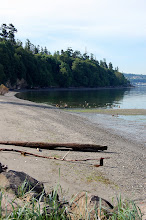
When gliding through the reef divers may see Rat fish, Giant Pacific Octopi, Sculpins, Rockfish, Gunnels, 
Even though the reefs are impressive and the marine life is spectacular, what was removed to create the reef may provide the most environmental benefit. Amy Rhodes with A2Z Scuba said that Saltwater is the first dive site in Washington created with the environment in mind. The Department of Natural Resources removed old tire pilings that were placed there in the 1970s. Toxins in the rubber had leached into the water over time, creating potential hazards for fish in Puget Sound and the people who ate them. Even though the tires were toxic, fish and wildlife made the tires their home, the new reef provides a home for these animals. Think of it as Extreme Home Makeover, the marine version.
This new habitat has another benefit to the community, a bonding tool for divers. Pictures and videos cannot capture the exhilaration of diving. Floating weightlessly through the water while breathing makes a diver feel like super hero--Aquaman to be specific. 
One of the most effective ways to change behavior regarding the environment is through awareness. The scuba divers serve top side as the eyes and ears of the marine animals. When divers exit the water people ask about what they see, why they dive, and if there are sharks. Amy said, "It creates awareness in the community. The more divers that use the park, the more people, especially children, ask about "what is out there". By educating the community, the more people want to help preserve Puget Sound." This is a perfect opportunity to share the environmental benefits of the reef and the negative affect humans can have on the marine environment. This awareness may help spawn more artificial reefs in the Puget Sound area. As more and more people share their underwater experiences marine preservation will continue to improve. The benefits of this reef reach far beyond its marine inhabitants.
Click here to read entire interview with Amy Rhodes…

